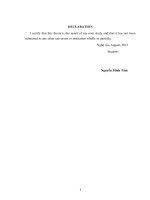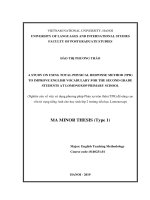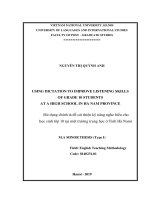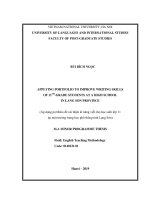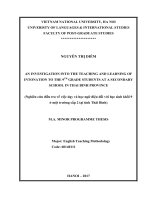Using mind mapping to teach vocabulary communicatively for the 5th form students at a primary school in ninh binh province
Bạn đang xem bản rút gọn của tài liệu. Xem và tải ngay bản đầy đủ của tài liệu tại đây (7.95 MB, 105 trang )
VIETNAM NATIONAL UNIVERSITY, HANOI UNIVERSITY OF
LANGUAGES AND INTERNATIONAL STUDIES FACULTY OF POSTGRADUATE STUDIES
PHAM THI HUONG
USING MIND-MAPPING TO TEACH VOCABULARY COMMUNICATIVELY
FOR THE 5
TH
FORM STUDENTS AT A PRIMARY SCHOOL IN NINH BINH
PROVINCE
(Sử dụng sơ đồ tư duy để dạy từ vựng theo đường hướng giao tiếp cho học sinh
lớp 5 tại một trường tiểu học ở tỉnh Ninh Bình)
M.A. MINOR PROGRAMME THESIS
FIELD: ENGLISH TEACHING METHODOLOGY
CODE: 8140231.01
HANOI – 2018
VIETNAM NATIONAL UNIVERSITY, HANOI UNIVERSITY OF
LANGUAGES AND INTERNATIONAL STUDIES FACULTY OF POSTGRADUATE STUDIES
PHAM THI HUONG
USING MIND-MAPPING TO TEACH VOCABULARY COMMUNICATIVELY
FOR THE 5TH FORM STUDENTS AT A PRIMARY SCHOOL IN NINH BINH
PROVINCE
(Sử dụng sơ đồ tư duy để dạy từ vựng theo đường hướng giao tiếp cho học sinh
lớp 5 tại một trường tiểu học ở tỉnh Ninh Bình)
M.A. MINOR PROGRAMME THESIS
FIELD:ENGLISH TEACHING METHODOLOGY
CODE: 8140231.01
SUPERVISOR: DR. TRAN THANH NHAN
HANOI – 2018
DECLARATION
I certify that I myself write this thesis entitled “Using mind-mapping to teach
vocabulary communicatively for the 5th form students at a primary school in
Ninh Binh Province”. It is not a plagiarism or made by others. Anything
related to others‟ works is written in quotation, the sources of which are listed
on the list of references. If then the pronouncement proves wrong, I am ready
to accept any academic punishment, including the withdrawal or cancellation
of my academic degree.
Signature
Student
Pham Thi Huong
ACKNOWLEDGEMENTS
First and foremost, I would like to express my gratitude to my
supervisor, Dr. Tran Thanh Nhan whose reference materials, support,
stimulating suggestions and encouragement helped me in all stages of this
research for and writing of this thesis. Without her critical comments and
valuable suggestions, this research could not have been completed.
I take this opportunity to express my sincere thanks to all my lecturers
in Faculty of Post-Graduate studies, University of Languages and
International Studies, National University, Hanoi for their lectures which
enable me to gain ample theoretical and practical knowledge.
Furthermore, I want to thank my colleagues and students at Phu Loc
Primary school who helped me carry out the investigation of the study.
Finally, I am really grateful to my family for their encouragement and
support to my process of writing of the thesis.
i
ABSTRACT
The aims of this research are to find out the effects of mind-mapping on
5th graders‟ vocabulary communicatively at Phu Loc Primary school. To limit
the aspects to be analyzed in this study, I formulate two research questions.
(1) To what extent does the use of mind-mapping affect the students‟
vocabulary acquisition and skills development? (2) What are the students‟
attitudes toward using mind-mapping in vocabulary learning?
In the study, I carried out an action research with the 5A students of Phu
Loc Primary school. Data of this study were obtained from the results of
questionnaires and from pre-test, while-test and post-test results. Two
instruments for collecting the data were (1) questionnaires toward vocabulary
learning before and after applying the mind -mapping in teaching vocabulary
and (2) the pre-test and post- test.
The findings of the data analysis showed that (1) Mind-mapping can help
the students to improve their abilities in retaining English vocabulary and
using it in communicative activities; (2) the students had positive attitudes
toward the mind-mapping.Thus, mind-mapping is hoped to be a promising
technique to teach and learn English.
ii
TABLE OF CONTENTS
DECLARATION
ACKNOWLEDGEMENTS............................................................................i
ABSTRACT.....................................................................................................ii
TABLE OF CONTENTS...............................................................................iii
LIST OF TABLES AND CHARTS...............................................................vi
PART A: INTRODUCTION.......................................................................... 7
1. Rationale of the study................................................................................... 7
2. Scope of the study.........................................................................................8
3. Research questions........................................................................................8
4. Aims of the study.......................................................................................... 9
5. Methods of the study.....................................................................................9
6. Organization of the thesis..............................................................................9
PART B: DEVELOPMENT.........................................................................10
CHAPTER I: LITERATURE REVIEW.................................................... 10
1.1. Vocabulary and its importance.................................................................10
1.1.1. Vocabulary definition............................................................................10
1.1.2. The role of vocabulary.......................................................................... 11
1.2. Mind mapping..........................................................................................12
1.2.1. Definition of mind map......................................................................... 12
1.2.2. Functions of mind-mapping..................................................................13
1.2.3. Characteristics of mind-mapping..........................................................13
1.2.4. Steps to create a mind map................................................................... 14
1.3. Mind mapping techniques........................................................................15
1.3.1. Definition of mind mapping techniques................................................15
1.3.2. The significance of mind-mapping in language classroom...................16
iii
1.3.3. The application of mind-mapping to teaching a foreign language.......17
1.4. Advantages and disadvantages of mind mapping techniques..................19
1.4.1. Advantages of mind mapping techniques..............................................19
1.4.2. Disadvantages of mind mapping techniques.........................................19
1.5. Summary..................................................................................................20
CHAPTER II: THE METHODOLOGY....................................................21
2.1. The context of the study...........................................................................21
2.2. Participants...............................................................................................21
2.3. Research methodology.............................................................................22
2.3.1. Action research definition..................................................................... 22
2.3.2. Action research procedure.................................................................... 23
2.3.3. Data collection instrument....................................................................24
2.3.4. Data collection procedure.....................................................................24
2.4. Setting of the Study..................................................................................25
2.5 Data collection instruments.......................................................................26
2.5.1. Tests.......................................................................................................26
2.5.2. Questionnaires...................................................................................... 27
2.6. Data analysis methods..............................................................................27
2.7 Summary...................................................................................................27
CHAPTER III: DATA ANALYSIS AND DISCUSSIONS.........................28
3.1. An analysis of the vocabulary scores....................................................... 28
3.2. An analysis of the writing scores............................................................. 31
3.3. An analysis of the reading scores.............................................................34
3.4. Evidence of speaking skill....................................................................... 35
3.5. Results from questionnaire.......................................................................38
PART C: CONCLUSION.............................................................................41
1. Pedagogical implications............................................................................ 41
iv
2. Limitations of the study ..............................................................................
3. Suggestions for further study ......................................................................
4. Conclusion ...................................................................................................
REFERENCES ..............................................................................................
APPENDICES ..................................................................................................
Appendix 1A(Test 1) ..........................................................................................
Appendix 1B ...................................................................................................
Appendix 1C ...................................................................................................
Appendix 2A(Test 2) .......................................................................................
Appendix 2B ..................................................................................................
Appendix 3A(Test 3) ....................................................................................
Appendix 3B ...................................................................................................
Appendix 4A(Test 4) ........................................................................................
Appendix 4B ...................................................................................................
Apendix 5A(Test 5) ........................................................................................
Appendix 5B ................................................................................................
Appendix 6A (Test 6) ...................................................................................
Appendix 6B ...............................................................................................
Appendix 6C .............................................................................................
Appendix 7 ...................................................................................................
Appendix 8 ...................................................................................................
Appendix 9 ................................................................................................
Appendix 10 ...............................................................................................
Appendix 11: SAMPLE LESSON PLAN ................................................
v
LIST OF TABLES AND CHARTS
I.LIST OF TABLES
Table 1: Procedure of the research..................................................................26
Table 2: Mean scores of test results................................................................ 33
Table 3: Correlation between test 1 and the other tests...................................33
Table 4: Mean scores, Min, Max of reading test results................................. 35
Table 5: Results of the questionnaire.............................................................. 39
II. LIST OF CHARTS
Figure 1: Action research cycle.......................................................................23
Chart 1: Results of the vocabulary pre- test....................................................28
Chart 2: Results of the vocabulary post- test.................................................. 29
Chart 3: Comparison between pre-test and post-test scores........................... 30
Chart 4: Results of the writing scores............................................................. 31
Chart 5: Results of the reading scores.............................................................34
vi
PART A: INTRODUCTION
1. Rationale of the study
English has been playing an important role in various aspects of life
such as education, entertainment, economy, science, culture and so on. It is a
useful tool for people to keep up with the latest technological developments in
the world.
Therefore, teaching and learning English is now considered as a
necessity in the society with the aim of mastering an international language.
English has become an integral part of general education and mostly a
compulsory subject from primary to tertiary level.
At Phu Loc primary school, English is a compulsory subject in the
curriculum. It is taught for 3rd, 4th and 5th form students to equip the students
with some basic knowledge to communicate and complete tasks in the
textbooks. After observing and conducting an interview at the school, the
teacher has identified a problem that involved the learning English
vocabulary ofPhu Loc primary students. They felt difficult to memorize and
recall English vocabulary items including their pronunciation, their spelling
and especially their meaning. The students usually cannot remember the
words for long and recall them when needed, hence, could not use vocabulary
to do the reading and writing tasks.
Vocabulary is a basic factor necessary for mastering a language. This is
because vocabulary is integral to every language skill, including reading,
writing, listening and speaking skill. Individuals cannot easily make
conversations or convey their thoughts in both oral and written forms without
having a certain level of vocabulary knowledge. David Wilkins (1972)
emphasized the importance of vocabulary as, “Without grammar, little can be
7
conveyed; without vocabulary, nothing can be conveyed”.
Therefore, the lack of vocabulary leads to many serious difficulties in
foreign language teaching and learning in Vietnam.Accordingly, low
proficiency poses a major obstacle to the students in acquiring the language
knowledge and taking part in class activities. It is clear that they could not
communicate well because they lack the words they need. They could not
practice writing tasks, either.
In fact, there are manyvocabularylearning techniques such as matching,
role play, semantic-mapping, dictionary use, learning vocabulary through the
context, and many others. The writer has a desire to help the students to be more
successful in using English vocabulary communicatively and to motivate them to
learn new words. For this purpose, I would like to conduct this study entitled:
“Usingmind-mapping to teach vocabulary communicatively for the 5
th
form
students at a primary school in Ninh Binh Province”.
2. Scope of the study
Concerning the scope of the study, some of the following factors should
be taken into consideration. Firstly, the subjects of the study are 31 5 th
students at Phu Loc primary school. Secondly, the writer chooses the 5 th form
students because she taught them in grade 3, 4 and observed that they do not
have sufficient vocabularies. Therefore, the writer would like to facilitate their
vocabulary learning help them to be interested in learning vocabulary. Thirdly,
the major purpose of this study is to motivate students to learn vocabulary
communicatively through mind mapping technique.
3. Research questions
The following research questions are formulated to address the
research theme:
1. To what extent does the use of mind-mapping affect the
students‟
8
vocabulary acquisition?
2.
What are its advantages towards teaching vocabulary
communicatively?
4.
Aims of the study
The
current
study
aims
at
motivating
learning
vocabulary
communicatively through mind mapping technique at Phu Loc primary school.
5. Methods of the study
This study was conducted as an action research with pretest, while test,
and posttest in order to determine the causal relationship between teaching
vocabulary through mind mapping and the enhancement of students‟
vocabulary retention, reading, writing, and speaking skills.
6. Organization of the thesis
Part A: Introduction introduces the rationale, the aims, the research
questions, the scope and the design of the study. Part B: Development is
divided into 3 chapters.
Chapter 1: Literature Review presents theories related to vocabulary, mindmapping.
Chapter 2: The study presents the research methods, the setting of the study,
the participants, the research data and the research procedures.
Chapter 3: Findings and Discussion presents the analysis of initial collected data
to determine the problems, then the action plan. The analysis of post-treatment
data was then presented along with which the discussions were given.
Part C: Conclusion provides the pedagogical implications, some limitations
of the study and suggestions for future study.
9
PART B: DEVELOPMENT
CHAPTER I: LITERATURE REVIEW
This chapter presents a brief review of the literature relevant to the
study. It consists of the theory of vocabulary and mind mapping technique.
1.1. Vocabulary and its importance
1.1.1. Vocabulary definition
Vocabulary plays a crucial part in the language learning process. Having a
wide range of vocabulary is strongly related to the degree of language
proficiency. Hence, it is necessary to clarify this term in this study at first.
So far there have been ample definitions of vocabulary. Specially, Ur
(1996) characterized vocabulary as the words we teach in the foreign
language. She also stated that a new item of vocabulary may be more than a
single word: a compound of two or three words or multi -word idioms. In
addition, Read (2001) viewed words as the basic building blocks of language,
the units of meaning from which the larger structures such as sentences,
paragraphs and whole texts are formed (p.1).
Vocabulary can be defined, roughly, according to the Cambridge Advanced
Learner‟s Dictionary, as following:
-
All the words known and used by a particular person
-
All the words which exist in a particular language or subject
In short, from the definition above, it can be concluded that vocabulary
is a list of words or a set of words in a language and knowledge of words
regarding its forms and meanings. In the present study, vocabulary refers to
the words, compounds and idioms in a language that have meanings used to
10
convey and receive information in oral and written communication.
1.1.2. The role of vocabulary
Even though vocabulary is the sub-set of a language, it plays a very
important role in language. No one can communicate in any meaningful way
without vocabulary. A large, rich vocabulary gives them the right words to use
at the right time.
According to Richards and Renandya in 2002, vocabulary is a core
component of language proficiency and provides much of the basis for how
well learners speak, listen, read, and write. Similar opinion was also expressed
by McCarthy who stated if you do not know enough vocabulary, you will not
be able to express yourself adequately. For learners, he also claimed that no
matter how well the students learn grammar, no matter how successfully the
sounds of L2 are mastered, without words to express a wider range of
meaning, communication in an L2 just cannot happen in any meaningful way.
Having a wide range of vocabulary, one‟s listening and reading will
improve because he/she will be able to understand more of what is written or
spoken. Their writing will become more effective and more powerful. A
person with a limited vocabulary will never be able to speak, write, read or
understand English effectively. Hence, vocabulary shortage affects all the
other skills.
Nation (2001) emphasized the need to constantly expand vocabulary
knowledge “acquisition of vocabulary is typically a more conscious and
demanding process”. Additionally, he claimed that even at an advanced level,
learners are aware of limitations in their knowledge of L2 words. He clarified the
11
importance of vocabulary by bringing evidence that vocabulary knowledge is
what the students most need while doing reading activities in order to make
sense of what they are reading. Moreover, it is his claim that those who do not
attain enough vocabulary cannot understand enough of what they read.
Furthermore, they have more limited contextual information provided by
known words to allow them to guess the meaning of unfamiliar words.
All in all, from various above points of view, vocabulary can be seen as
a priority area in language learning and teaching. However, the main obstacle
all students face in vocabulary learning is to recall words or memorize words
to use them effectively in communicative situations. Therefore, a focus on
improving vocabulary retention is essential for learners to raise their English
proficiency.
1.2. Mind mapping
1.2.1. Definition of mind map
Mind map, according to Buzan (2006), is a technique of making an
outline which used the represent words, ideas, tasks, or another linked to an
arranged radically around a central key word or idea by lines and typically it
contains words, ideas, short phrases or pictures.
Furthermore, Marton & Booth (1997) state that Mind map is a tool for
enhancing learning and thinking. It provides a structure to reveal various
aspects of a story such as the sequence of events, the key points, the cause and
effect, the relation of ideas and so on. Students can use mind maps for
revising and clarifying thoughts so as to get the deep meaning of a story.
Additionally, Murley (2007) affirms that mind maps are a non linear visual
outline of complex information that can aid creativity, organization,
productivity, and memory. With the same opinion, Paul Emmerson (cited in
12
the article “Using Mind Map in BE”, 2010) affirmed that “a mind map is a
way of making notes that is intuitive and highly personal. You put „your
world‟ down on paper as a visual diagram and then use it as the basis for a
speaking activity. There is a central topic in the middle, surrounded by subtopics linked to it with lines. The sub-topics have further branches, according
to the ideas/imagination of the person who draws the mind map (or the
instructions of the teacher)”.
In brief, mind map is a diagram used to visually outline information. It
is often created around a single word or text, placed in the center, to which
associated ideas, words and concepts are added.
1.2.2. Functions of mind-mapping
According to Buzan (2009:6), mind-mapping have the following
functions:
*
To make active all parts of brain.
*
To make people (learners) focus on the main topic.
*
To help show the relation among parts of information
*
To give a certain illustration in the whole and detail.
*
To help group the concept and compare it.
1.2.3. Characteristics of mind-mapping
The mind map has four essential characteristics:
*
*
The subject of attention is crystallized in a central image.
The main themes of the subject radiate from the central image on
branches.
*
Branches hold a key image word printed on the associated line-details
radiate out.
*
The branches form a connectedstructure
13
1.2.4. Steps to create a mind map
Al Naqbi (2012: 15) suggests that there are seven steps in developing Mind
Map. They are:
a) Starting from the center of blank paper, the long side of which is put
flatly.
b) Using picture or photograph for central idea. It is because a picture or
photograph will have a thousand words helping the brain use imagination to
express.
c) Using attractive color. It is because for brain, color is as interesting as
picture.
d) Connecting the main branches to central picture, and connecting the
second-order and third-order branches to the first-, second-order, and so on.
e) Drawing curving rather than straight connecting line. It is because straight
line will make the brain bored.
f) Using one keyword for each line. It is because a single member keyword
has more power and flexibility in mind mapping.
g) Using pictures. It is because every central picture means a thousand words
(See the example of mind map guidelines)
14
1.3. Mind mapping techniques
1.3.1. Definition of mind mapping techniques
Buzan (cited in Yusuf Effendi 2004) states that a mind mapping is a
powerful graphic technique which provides a universal key to unlock the
potential of the brain. It is visual map of ideas, laid out in a radial format
around a central thought and it involves a unique combination of imagery,
colour and visual-spatial arrangement which is proven to significantly
improve recall when compared to conventional methods of note-taking and
rote learning. It needs imagination and association to activate our brain in
remembering something.
Based on DePotter and Hernacki as translated into English (2008) mind
15
mapping is the use of whole brains technique by using the visualization and
other graphic infrastructure to make an impression.
Antonacci (1991) advocates that mind mapping as an effective post
reading strategies as well because it provides students with a tool to recall,
organize, and represent visually the new information in conjunction with the
old information.
In summary, Mind mapping can help poor readers to read more
effectively because the format can show the relative importance of individual
points and the way in which facts relate to one another.
1.3.2. The significance of mind-mapping in language classroom
MM
is an effective form of vocabulary learning and teaching tool
because it can activate prior knowledge on a certain topic and help learners to
organize and recall items of vocabulary (according to Casco in 2009). When
using MM, the teacher starts with main topic or the theme as the central idea
and the students think about the new and the old items related to the topic
given. Therefore, this will lead to more comfortable and more active learning
atmosphere which is effective for longer retention of the learnt words.
Additionally, MM can promote interactive learning process. By
implementing the MM technique in teaching, both the teacher and students
can work together to build on the map building involving the targeted content.
The teacher can help students to recall the prior knowledge related to the topic
given. MMs provide students with an active interaction allowing them to learn
through the use of a central image. They are encouraged to join in and express
their ideas to the map building. The constructing process of map building
involving discussing in groups/ class, writing words down, categorizing and
16
grouping words with related ones can reduce the students‟ passive learning in
vocabulary lesson.
Furthermore, MM is a pattern which at least consists of picture, symbol
and color that will not just make the students more enjoyable and interested in
studying vocabulary but also help them to remember vocabulary faster.
To sum up, MM can be an effective technique in vocabulary learning
and teaching for the improvement of vocabulary retention. Following is the
review of the studies related to this study.
1.3.3. The application of mind-mapping to teaching a foreign language.
It is obvious that memory plays an important role in learning and
mastering a foreign language. In communicative approach, learners need to
retain words and use them effectively.
Mind-mapping is a helpful memory technique which makes it easier to
remember new materials and to visualize the thinking process, so mindmapping proves to be a very helpful tool to master a foreign language.
Although it may cost time to use the technique, it will eventually speed up the
learning process when learners know and understand how to use it.
Casco (2009) suggests some applications of mind-mapping in teaching
a foreign language which can be presented as follows:
Engage the learners:
Thanks to the map, the learners know easily what comes next and focus
the learners‟ attention on the topic. Moreover, the map supports a structure to
reduce the learners‟ anxiety when they receive input through listening and
reading when they speak.
Active prior knowledge
17
The use of keywords stimulates memory of what the student know
about the topic.
Encourage the learner to ask questions:
The map shows clearly what the students know and what they do not
know about the topic. Image and interrogation marks widen the information
gap and encourage the learners to find out what they do not know.
Scaffold reading and listening comprehension:
The map is an efficient tool to facilitate comprehension because it
offers the students a globe view of listening or reading contents. Furthermore,
the cues showing in the map helps the learner to form inferences as an aid to
understanding.
Scaffold speaking
The map helps the learner to organize their thought and speech. The
different linked and cross-referenced elements of the map allow the learner to
create a various discourse each time he/she use the map.
Assess oral production
The map can assess the students‟ oral production by explaining the link
of the maps. The learner has to use new structures and lexical items to
introduce the content of the map.
Scaffold written production
The map can be considered the starting point or the outline to write a
paragraph or an essay on the topic explored.
Casco (2009) showed that mind-mapping has ample benefits in
teaching a foreign language in many aspects consisting of reading, writing,
reading skill as well as in motivating the learners and activating the prior
18
knowledge.
1.4. Advantages and disadvantages of mind mapping techniques
1.4.1. Advantages of mind mapping techniques
Buzan (2007) proposes to use mind mapping technique because it
makes students to be imaginative, to find new ideas, to save time, to be
creative, to keep note, to develop a concept, and to perform a presentation.
Similarly, Hofland (2007) argues that mind mapping can contribute to
learners‟ motivation because of its creative aspects. This statement is
supported by Bono (1969) (as cited in Hofland (2007)) who states that
“creativity is a great motivator because it makes people interested in what
they are doing. Creativity gives hope that there can be a worthwhile idea.
Creativity gives the possibility of some sort of achievement to everyone.
Creativity makes life more fun and more interesting”.Additionally, Stanley
(2004) affirmed that mind mapping techniques can help students generate
their ideas more easily. Based on theories above, it can be concluded that the
use of mind mapping technique in classroom is effective because it could
increase student‟s motivation and aid the teachers to explain the learning
materials.
1.4.2. Disadvantages of mind mapping techniques
Although using mind mapping technique in teaching reading text
summary has many advantages, there are some disadvantages when using
them for both teachers and students. Firstly, using MM in summarizing the
text is time consuming for teachers, they have to spend a lot of time preparing
MM by either hand made or software on computer in advance. Besides, using
MM is only effective and easy when the classrooms have a computer and
19
projector. However, not every classroom has these teaching aids. Furthermore,
making MM costs the teachers a lot of money if they draw mind maps by
hand. For instance, teachers have to print, or buy pictures or posters from the
bookshops to stick on mind maps. Moreover, the students also have
difficulties in constructing MM, and the way they solve it. Most of students
were still confused with new words, finding the key words and making
branches in making MM. Last but not least, students have less collaboration
with friends because each student was busy with her/ his work.
1.5. Summary
This chapter was an overview of literature related to the study. The first
section of this chapter reviewed definitions of vocabulary and its importance.
The second part discussed mind mapping. Next, mind mapping techniques
were mentioned. This chapter ended with the advantages and disadvantages of
mind mapping techniques.
20
CHAPTER II: THE METHODOLOGY
As introduced in part A, this chapter was to test the effectiveness of
teaching vocabulary communicatively through mind mapping.
2.1. The context of the study
The participants of the study are 5th form students of Phu Loc primary
school and 3 English teachers working at this school.
As for students, they are mostly children of the farmers in a rural area of
the North Vietnam. Their English is of different levels, which means there
are both excellent and weak students.
As for 3 English teachers, all are female; both of them have university
degrees in teaching English as a foreign language. Their teaching experience
ranges from 3 years to 5 years.
At Phu Loc primary school, English is one of the compulsory subjects in
the curriculum. “Tieng Anh 5” textbook consists of twenty units for two
terms. The course book is designed in themes with familiar topics to children.
Each theme includes five topics, a review and a short story. Learning activities
in each topic are organized into three lessons for four skills (listening,
speaking, reading, and writing) and basic language knowledge (phonics,
vocabulary, grammar). Learning activities are suitable with young learners‟
characteristics, with Vietnamese culture as well as international interaction.
2.2. Participants
The participants of this study are the 5th students of Phu Loc primary school.
of 12 females and 19 males. The
The class has 31 students, consisting
21


